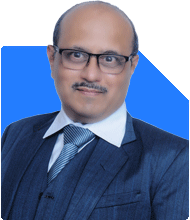Nitin Narkhede | Answer |Ask -Follow
MF, PF Expert - Answered on Sep 14, 2024
As a mentor, Nitin has trained over 1,000 individuals, many of whom have seen remarkable financial transformations.
Nitin holds various certifications including the Association Of Mutual Funds in India (AMFI), the Insurance Regulatory and Development Authority and accreditations from several insurance and mutual fund aggregators.
He is a mechanical engineer from the J T Mahajan College, Jalgaon, with 34 years of experience of working with MNCs like Skoda Auto India, Volkswagen India and ThyssenKrupp Electrical Steel India.... more

Hi, am 45-year-old seeking retirement planning advice. Am having a net saving of 4 Crores (2.75 Crores in MF, 1 Crores in FD and the rest in PPF and Sukanya scheme. If I keep on investing 3 lacs /month for 5 years what kind of corpus am looking to create .My MF portfolio consist of: Axis Mid cap, DSP Equity opportunities, Edelweiss Balanced advantage, Edelweiss Midcap, HDFC Small cap, HSBC Midcap,Invensco india Midcap, Invesco India small cap, Kotak emerging equity, Koal flexicap , Mirae assets large and midcap, SBI balanced advantage, Tata balanced advantage, Tata Mid cap, Whiteoak capital . thanks in advance
Great to that you are committed in your investments and keen to have your retirement planning query resolved. It's great to see that you're proactively managing your finances. Very few people are managing their own finances. I always recommend my clients to take hold of your finances and do not depend on any other person or advice. Let’s see what kind of corpus you might expect after five years, along with some suggestions for your mutual fund portfolio. Assumed Annual Return 6% Fixed Deposit, Assumed Annual Return:** 7.5% for PPF and Sukanya Scheme. Assumed Annual Return 10% on Mutual Funds. you can expect approximately ?8.45 Crores after 5 years. your investment is highly dependent on Equity related Mutual funds which consider high risk .
Some recommendations, Consolidate Similar Funds, Having too many funds in the same category can lead to overlapping investments and doesn't significantly increase diversification.
Diversify Across Market Caps Ensure you have exposure to large-cap, mid-cap, and small-cap funds for balanced growth. They offer low-cost diversification and track market indices.
Regularly Review Performance of your funds against benchmarks. As you're approaching 50, consider gradually shifting a portion of your investments to less volatile instruments like debt funds or fixed-income securities. Consider Index Funds or ETFs.
Ensure you have an emergency fund covering at least 6 months of expenses. Be mindful of the tax implications of your investments, especially when redeeming or rebalancing. Consult a Financial Advisor
Best regards,
Nitin Narkhede
Founder & MD, Prosperity Lifestyle Hub https://Nitinnarkhede.com
Free Webinar https://bit.ly/PLH-Webinar
You may like to see similar questions and answers below
Omkeshwar Singh | Answer |Ask -Follow
Head, Rank MF - Answered on Nov 06, 2020
Nikunj Saraf | Answer |Ask -Follow
Mutual Funds Expert - Answered on May 24, 2023
Ramalingam Kalirajan |10871 Answers |Ask -Follow
Mutual Funds, Financial Planning Expert - Answered on May 11, 2024
Ramalingam Kalirajan |10871 Answers |Ask -Follow
Mutual Funds, Financial Planning Expert - Answered on Dec 25, 2024
Ramalingam Kalirajan |10871 Answers |Ask -Follow
Mutual Funds, Financial Planning Expert - Answered on Jul 10, 2025
Mihir Tanna |1090 Answers |Ask -Follow
Tax Expert - Answered on Dec 06, 2025
Ramalingam Kalirajan |10871 Answers |Ask -Follow
Mutual Funds, Financial Planning Expert - Answered on Dec 06, 2025
Radheshyam Zanwar |6734 Answers |Ask -Follow
MHT-CET, IIT-JEE, NEET-UG Expert - Answered on Dec 06, 2025
Radheshyam Zanwar |6734 Answers |Ask -Follow
MHT-CET, IIT-JEE, NEET-UG Expert - Answered on Dec 06, 2025
Radheshyam Zanwar |6734 Answers |Ask -Follow
MHT-CET, IIT-JEE, NEET-UG Expert - Answered on Dec 06, 2025
Dr Dipankar Dutta |1837 Answers |Ask -Follow
Tech Careers and Skill Development Expert - Answered on Dec 05, 2025
Dr Shyam Jamalabad |108 Answers |Ask -Follow
Dentist - Answered on Dec 05, 2025
Dr Shyam Jamalabad |108 Answers |Ask -Follow
Dentist - Answered on Dec 05, 2025
Dr Shyam Jamalabad |108 Answers |Ask -Follow
Dentist - Answered on Dec 05, 2025
Dr Dipankar Dutta |1837 Answers |Ask -Follow
Tech Careers and Skill Development Expert - Answered on Dec 05, 2025





























